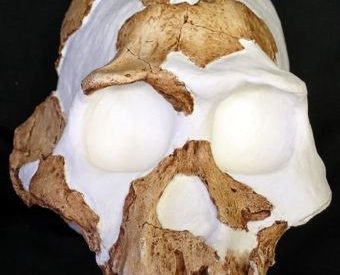
Many of you might think that we are the only species of the human genus that ever walked on this planet. But the truth is that Homo sapiens(modern humans) is the only surviving species in the genus, all others having become extinct.
1. Homo gautengensis
 Reconstruction of the skull of a Homo gautengensis.
Reconstruction of the skull of a Homo gautengensis.
Homo gautengensis had big teeths suitable for chewing plant materials. It was small brained and was probably an ecological specialist. It apparently produced and used stone tools and may even have made fire, as there is evidence for burnt animal bones associated with Homo gautengensis? remains.
This species stood just over 3 feet (0.91 m) tall and weighed about 110 pounds (50 kg). It could walk on two feet when on the ground, but probably spent considerable time in trees, perhaps feeding, sleeping and escaping predators.
Though most of the researchers believe it lacked speech and language skills. Due to its anatomy and geological age, researchers think that it was a close relative of Homo sapiens but not necessarily a direct ancestor.
2. Homo habilis
 A relatively complete skull of a Homo habilis which dates to 1.9 Million years old.
A relatively complete skull of a Homo habilis which dates to 1.9 Million years old.
Homo habilis is the least similar to modern humans of all species in the genus Homo, and its classification as Homo has been the subject of controversial debate since its first proposal in the 1960’s. Homo habilis was short and had disproportionately long arms compared to modern humans.
Homo habilis had a cranial capacity slightly less than half of the size of modern humans. Despite the ape-like morphology of the bodies, Homo habilis remains are often accompanied by primitive stone tools.
3. Homo ergaster
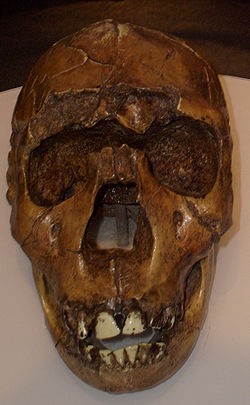 Turkana Boy, Homo ergaster skull.
Turkana Boy, Homo ergaster skull.
Homo ergaster had thinner bones, more protrusive face, and lower forehead. This species had reduced sexual dimorphism,a smaller more orthognathous (less protrusive) face, a smaller dental arcade, and a larger cranial capacity(700?900 cm in earlier Homo ergaster specimens, and 900?1100 in later specimens).
Homo ergaster remained stable for ca. 500,000 years in Africa before disappearing from the fossil record around 1.4 million years ago. No identifiable cause has been attributed to this disappearance. Not only was H. ergaster like modern humans in body, but also more in organisation and sociality than any earlier species.
It was thought for a long time that Homo ergaster was restricted in the physical ability to regulate breathing and produce complex sounds. This was based on Turkana Boy?s cervical vertebra, which were far narrower than in later humans. However, later discoveries of cervical vertebrae in Dmanisi, Georgia, which were some 300,000 years older than those of Turkana Boy, were well within the normal range of human vertebrae range.
4. Homo erectus
 Skull of a Homo erectus
Skull of a Homo erectus
Homo erectus had a cranial capacity greater than that of Homo habilis the earliest remains show a cranial capacity of 850 cm, while the latest Javan specimens measure up to 1100 cm, overlapping that of Homo sapiens.; the frontal bone is less sloped and the dental arcade is smaller. The face is more orthognatic (less protrusive), with large brow-ridges and less prominent zygomata(cheekbones). These early hominins stood about 1.79 m (5 ft 10 in),(Only 17 percent of modern male humans are taller) and were extraordinarily slender, with long arms and legs. The sexual dimorphism between males and females was slightly greater than seen in Homo sapiens, with males being about 25% larger than females.
Homo erectus, however, used comparatively primitive tools. It has been suggested that Homo erectus may have been the first hominid to use rafts to travel over oceans. East African sites, such as Chesowanja near Lake Baringo, Koobi Fora, and Olorgesailie in Kenya, show some possible evidence that fire was utilized by early humans. At Chesowanja, archaeologists found red clay sherds dated to be 1.42 Million years ago. Reheating on these sherds show that the clay must have been heated to 400 C (752 F) to harden. It is known, from the study of microwear on handaxes, that meat formed a major part of the erectus diet.
Homo erectus was probably the first hominid to live in small, familiar band-societies similar to modern hunter-gatherer band-societies. Homo erectus is thought to be the first hominid to hunt in coordinated groups, use complex tools, and care for infirm or weak companions.
5. Homo rudolfensis
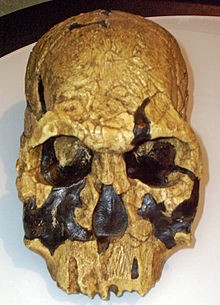 Reconstruction of the skull of a Homo rudolfensis.
Reconstruction of the skull of a Homo rudolfensis.
In Homo rudolfensis the cranial capacity based on the new construction was reported to be downsized from 752 cm to about 526 cm. When compared to other older Homo habilis fossils, the mandible and the jaw of homo rudolfensis did not fit within the limits of variation of the Homo habilis. Homo rudolfensis displays less prognathism and a more rounder braincase rather than a bunning brain case.Even if sexual dimorphism were considered, the size difference in the mandible and teeth would be too great compared to Homo habilis. A male Homo rudolfensis has massive teeth in comparison to a female Homo habilis, and it portrays a much larger brain case.
6. Homo antecessor
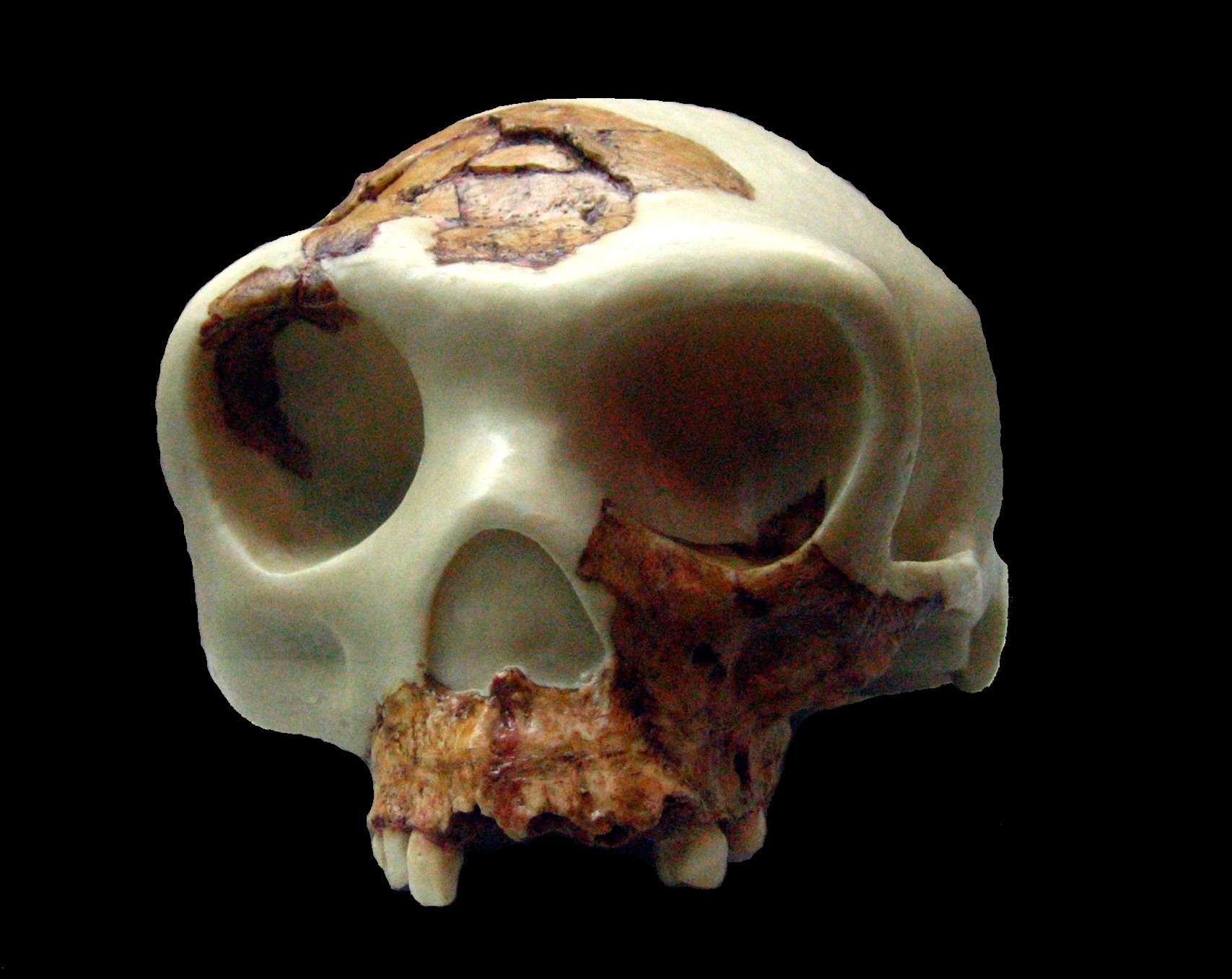 Reconstruction of a Homo antecessor
Reconstruction of a Homo antecessor
Homo antecessor was about 1.6?1.8 m (5?6 feet) tall, and males weighed roughly 90 kg (200 pounds). Their brain sizes were roughly 1,000?1,150 cm, smaller than the 1,350 cm average of modern humans. Due to fossil scarcity, very little more is known about the physiology of Homo antecessor.
Homo antecessor might have been right-handed, a trait that makes the species different from the other apes. This hypothesis is based on tomography techniques. Arsuaga also claims that the frequency range of audition is similar to Homo sapiens, which makes him suspect that Homo antecessor used a symbolic language and was able to reason. Arsuaga?s team is currently pursuing a DNA map of Homo antecessor. Based on teeth eruption pattern, the researchers think that Homo antecessor had the same development stages as Homo sapiens, though probably at a faster pace. Other significant features demonstrated by the species are a protruding occipital bun, a low forehead, and a lack of a strong chin.
The molar was described as ?well worn? and from an individual between 20 and 25 years of age. Additional findings announced on 27 March 2008 included the discovery of a mandible fragment, stone flakes, and evidence of animal bone processing.
7. Homo cepranensis
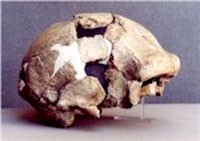 The only one skull cap of a Homo Cepranensis
The only one skull cap of a Homo Cepranensis
Homo cepranensis is a proposed name for a human species, known from only one skull cap discovered in 1994.
The age of the fossil is estimated to be between 350,000 to 500,000 years old.
8. Homo heidelbergensis
 Skull of a Homo heidelbergensis
Skull of a Homo heidelbergensis
Homo heidelbergensis are likely to be descended from the morphologically very similar Homo ergaster from Africa. But because Homo heidelbergensis had a larger brain-case ? with a typical cranial volume of 1100?1400 cm overlapping the 1350 cm average of modern humans ? and had more advanced tools and behavior, it has been given a separate species classification. Male heidelbergensis averaged about 1.75 m (5 ft 9 in) tall and 62 kg (136 lb). Females averaged 1.57 m (5 ft 2 in) and 51 kg (112 lb). A reconstruction of 27 complete human limb bones found in Atapuerca (Burgos, Spain) has helped to determine the height of Homo heidelbergensis; the conclusion was that most Homo heidelbergensis averaged about 170 cm (5 ft 7in) in height. Though numerous fossil bones indicate some populations of heidelbergensis were ?giants? routinely over 2.13 m (7 ft) tall and inhabited South Africa between 500,000 and 300,000 years ago.
Findings in a pit in Atapuerca (Spain) of 28 human skeletons suggest that Homo heidelbergensis might have been the first species of the Homo genus to bury its dead. Homo heidelbergensis acquired a pre-linguistic system of communication. No forms of art or sophisticated artifacts other than stone tools have been uncovered, although red ochre, a mineral that can be used to mix a red pigment which is useful as a paint, has been found at Terra Amata excavations in the south of France.
The morphology of the outer and middle ear suggests they had an auditory sensitivity similar to modern humans and very different from chimpanzees. They were probably able to differentiate between many different sounds. Dental wear analysis suggests they were as likely to be right-handed as modern people.500,000 year-old hafted stone points used for hunting are found and tested by way of use-wear replication.
9. Homo rhodensiensis
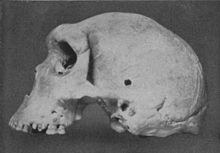 Homo rhodensiensis skull found in 1921.
Homo rhodensiensis skull found in 1921.
This cranium of a Homo rhodensis was found in a lead and zinc mine in Broken Hill, Northern Rhodesia (now Kabwe, Zambia) in 1921 by Tom Zwiglaar, a Swiss miner. In addition to the cranium, an upper jaw from another individual, a sacrum, a tibia, and two femur fragments were also found. The skull was dubbed ?Rhodesian Man? at the time of the find, but is now commonly referred to as the Broken Hill skull or the Kabwe cranium.The skull is from an extremely robust individual, and has the comparatively largest brow-ridges of any known hominid remains.
10. Homo neanderthalensis
 Skull of a Neanderthal
Skull of a Neanderthal
They are closely related to modern humans, differing in DNA by just 0.12%. Remains left by Homo Neanderthals include bone and stone tools, which are found in Eurasia, from Western Europe to Central and Northern Asia. The species is named after Neandertal (?Neander Valley?), the location in Germany where it was first discovered. Comparison of the DNA of Neanderthals and Homo sapiens suggests that they diverged from a common ancestor between 350,000 and 400,000 years ago.
11. Homo sapiens idaltu
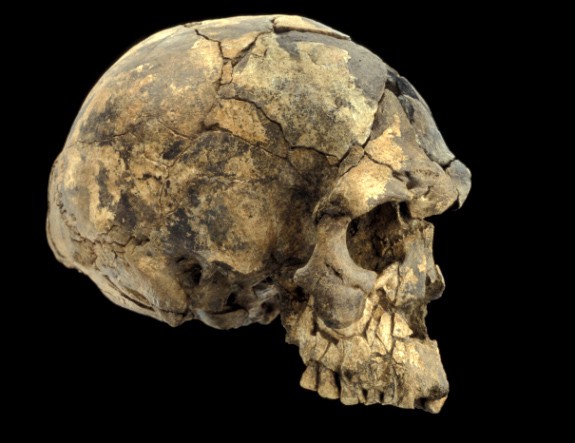 Skull of a Homo sapiens idaltu.
Skull of a Homo sapiens idaltu.
Homo sapiens idaltu is an extinct subspecies of Homo sapiens that lived almost 160,000 years ago in Pleistocene Africa. ?Idaltu? is from the Saho-Afar word meaning ?elder? or ?first born?
The fossilized remains of Homo sapiens idaltu were discovered at Herto Bouri near the Middle Awash site of Ethiopia?s Afar Triangle in 1997 by Tim White, but were first unveiled in 2003. Herto Bouri is a region of Ethiopia under volcanic layers. By using radioisotope dating, the layers date between 154,000 and 160,000 years old. Three well preserved crania are accounted for, the best preserved being from an adult male having a brain capacity of 1,450 cm3 (88 cu in). The other crania include another partial adult male and a six-year-old child.
12. Homo floresiensis (Hobbit)
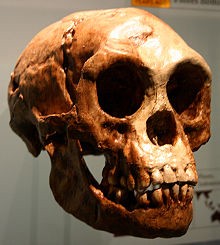 A cast of the Homo florensis skull.
A cast of the Homo florensis skull.
Homo floresiensis (?Flores Man?; nicknamed ?hobbit? and ?Flo?) is widely believed to be an extinct species in the genus Homo. The remains of an individual that would have stood about 3.5 feet (1.1 m) in height were discovered in 2003 on the island of Flores inIndonesia. Partial skeletons of nine individuals have been recovered, including one complete skull.
These remains have been the subject of intense research to determine whether they represent a species distinct from modern humans. This hominin is remarkable for its small body and brain and for its survival until relatively recent times (possibly as recently as 12,000 years ago).
Recovered alongside the skeletal remains were stone tools from archaeological horizons ranging from 94,000 to 13,000 years ago. Some scholars suggest that the historical Homo floresiensis may be connected by folk memory to ebu gogo myths prevalent on the isle of Flores.
13. Denisova hominin (Denisovan)
 Two teeths that were found of Denisova Hominins
Two teeths that were found of Denisova Hominins
Denisovans or Denisova hominins are an extinct species of human in the genus Homo. In March 2010, scientists announced the discovery of a finger bone fragment of a juvenile female who lived about 41,000 years ago, found in the remote Denisova Cave in the Altai Mountains in Siberia, a cave which has also been inhabited by Homo neanderthalensis and Homo sapiens modern humans. Two teeth and a toe bone belonging to different members of the same population have since been reported.
14. Red Deer Cave people
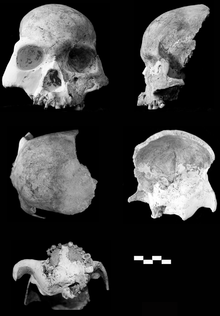 A partial skull of a Red Deer Cave People
A partial skull of a Red Deer Cave People
The Red Deer Cave People were the most recent known prehistoric population that do not resemble modern humans. Fossils dated between 14,500 and 11,500 years old were found in Red Deer Cave and Longlin Cave in China. Having a mix of archaic and modern features, they are tentatively thought to be a separate species of humans that became extinct without contributing to the gene pool of modern humans. Evidence shows large deer were cooked in the Red Deer Cave, giving the people their name.
Fossils of the Red Deer Cave people were radiocarbon dated between 14,500 and 11,500 years of age, using charcoal found in the fossil deposits. During the period the Red Deer Cave people lived, all other prehistoric human species such as Neanderthals were thought to have died out. The Red Deer Cave humans would therefore be more recent than Homo floresiensis(dubbed ?Hobbits?) dated to 13,000 years ago.
In spite of their relatively recent age, the fossils exhibit features of more primitive humans. The Red Deer Cave dwellers had the following distinctive features that differ from modern humans: flat face, broad nose, jutting jaw with no chin, large molars, prominent brows, thick skull bones, and moderate-size brain. Although the physical features of the Red Deer Cave people suggest that they may be a previously undiscovered species of prehistoric human, the scientists who discovered them are reluctant to classify them as a new species
15. Us (Homo sapiens)
 A young member of our species.
A young member of our species.
Modern humans (Homo sapiens or Homo sapiens sapiens) are the only extant members of the hominin clade, a branch of great apes characterized by erect posture and bipedal locomotion; manual dexterity and increased tool use; and a general trend toward larger, more complex brains and societies.
